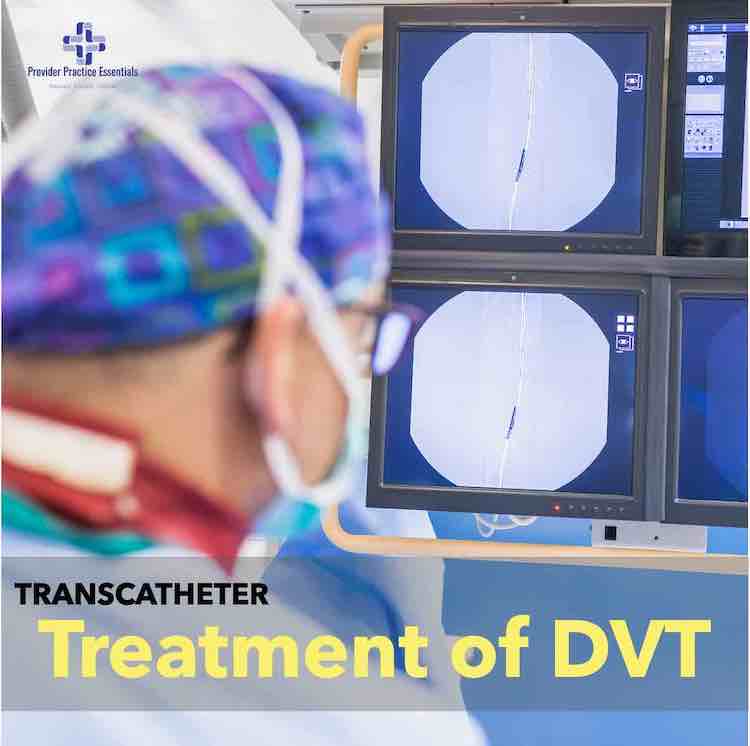Rob Beatty, MD FACEP
Introduction
Deep Venous Thrombosis (DVT) is a common vascular condition characterized by the formation of blood clots within the deep veins, predominantly in the lower extremities.
Traditionally, the management of DVT also involves medical therapy with anticoagulants.
Recent advancements in interventional radiology have also led to the development of percutaneous transcatheter treatment options for DVT.
This article aims to provide medical providers with an concise overview of these innovative techniques, approaches, and indications, while also comparing mechanical removal to medical therapy.
Percutaneous Transcatheter Treatment Techniques and Approaches:
Catheter-Directed Thrombolysis (CDT) for DVT
CDT involves the administration of thrombolytic agents directly into the thrombus through a catheter. Likewise, this technique aims to dissolve the clot and restore venous patency. CDT can be further classified into two approaches:
a. Pulse-Spray Technique: Thrombolytic agents are rapidly infused into the clot using a high-pressure catheter, enhancing the contact between the agent and also the thrombus for more effective clot dissolution.
b. Dwell Technique: Thrombolytic agents are slowly infused into the clot, allowing a prolonged dwell time within the thrombus also to promote clot lysis.
Mechanical Thrombectomy for DVT
Mechanical thrombectomy also involves the physical removal or fragmentation of the clot using specialized devices. This technique is particularly useful in patients with large clot burdens, contraindications to thrombolytic therapy, or those who have failed medical therapy. Mechanical thrombectomy can be achieved through the following methods:
a. Catheter-Based Mechanical Thrombectomy: Utilizes various devices such as rotating helical or suction catheters to physically remove the clot.
b. Rheolytic Thrombectomy: Involves the use of a high-velocity saline jet to macerate the thrombus, also followed by aspiration of the fragmented clot.
c. AngioJet Thrombectomy: Also uses a catheter with high-velocity saline jets and a suction device to fragment and aspirate the thrombus.

Indications for Percutaneous Transcatheter Treatment:
Phlegmasia Cerulea Dolens: A severe form of DVT characterized by extensive venous thrombosis also causing limb-threatening ischemia.
Massive or Submassive Pulmonary Embolism (PE): When DVT extends into the proximal deep veins, also increasing the risk of PE.
Symptomatic Iliofemoral DVT: Involvement of the iliac and also femoral veins, causing significant symptoms, impaired venous return, or limb swelling.
Failure of Anticoagulant Therapy: Patients who do not demonstrate sufficient improvement with medical therapy alone.
Comparison of Mechanical Removal and Medical Therapy for DVT:
| Treatment Options | Indications | Contraindications | Cost (approximate) |
|---|---|---|---|
| Mechanical | Large clot burden | – Active bleeding | Varies based on devices and also healthcare system |
| Thrombectomy | – Contraindications to Thrombolytic therapy – Failure of Medical Therapy | – Recent surgery or major trauma – Intracranial hemorrhage – Severe coagulopathy | Varies based on devices and also healthcare system |
| Catheter-Directed | – Symptomatic iliofemoral DVT | – Active bleeding | Thrombolytic agent cost varies |
| Thrombolysis | – Massive or submassive PE – Phlegmasia cerulea dolens – Failure of medical therapy | – Recent surgery or major trauma – Intracranial hemorrhage – Severe coagulopathy |
Sources:
- Vedantham S, Goldhaber SZ, Julian JA, et al. Pharmacomechanical Catheter-Directed Thrombolysis for Deep-Vein Thrombosis. N Engl J Med. 2017;377(23):2240-2252.
- Mahnken AH, Thomson K, de Gregorio MA. Percutaneous Thrombectomy in Acute Deep Vein Thrombosis: A Review of Devices and Clinical Efficacy. J Vasc Interv Radiol. 2020;31(4):616-625.
- Meissner MH, Gloviczki P, Comerota AJ, et al. Early Thrombus Removal Strategies for Acute Deep Venous Thrombosis: Clinical Practice Guidelines of the Society for Vascular Surgery and the American Venous Forum. J Vasc Surg. 2012;55(5):1449-1462.
